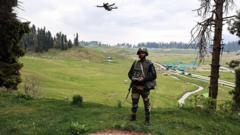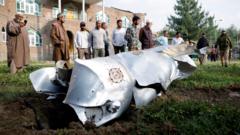As tensions between India and Pakistan escalate, both nations are increasingly relying on drone technology in their military strategies. This modern facet of warfare may alter the longstanding conflict dynamics as accusations and counterclaims intensify following recent attacks.
Rising Drone Warfare Escalates India-Pakistan Tensions in Kashmir

Rising Drone Warfare Escalates India-Pakistan Tensions in Kashmir
The ongoing conflict over Kashmir between India and Pakistan takes a new turn with increased drone warfare, heightening fears of a broader military engagement.
In a notable shift in the ongoing Kashmir conflict, India and Pakistan have embraced drone warfare, marking a significant escalation in their military confrontations. Reports from both sides indicate a surge in aerial activity, with India's defense officials claiming that the Pakistani military has executed drone intrusions at around 36 locations, utilizing between 300 to 400 drones to challenge India’s air defenses. This activity has sparked concerns over possible violations of airspace and a potential increase in hostilities.
The backdrop for this heightened aggression stems from a recent militant attack in India-controlled Kashmir, claiming 26 lives and prompting India to accuse Pakistan of complicity. In retaliation, India executed airstrikes within Pakistani territory, further stoking the fires of conflict. The Pakistani military has countered these claims, asserting that it successfully downed 25 Indian drones, including instances over Karachi and Rawalpindi, the latter being significant as the center for Pakistan's intelligence activities.
The nature of this conflict has changed as drones—previously a feature of modern warfare predominantly utilized by various nations worldwide—are now being used in a bilateral conflict between two nuclear-armed states, illustrating an evolution in how warfare is conducted. Experts suggest that this new dimension could reshape the international understanding of hostilities between India and Pakistan, similar to the global perspective shift that followed their nuclear armament in the 1990s.
As the situation evolves, both countries continue to engage in a cycle of accusations, counterclaims, and misinformation, signaling a potential for further escalation in hostilities in one of the world's most enduring conflicts.



















